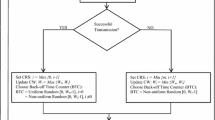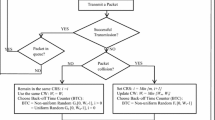Abstract
The binary exponential backoff (BEB) mechanism is applied to the packet retransmission in lots of wireless network protocols including IEEE 802.11 and 802.15.4. In distributed dynamic network environments, the fixed contention window (CW) updating factor of BEB mechanism can’t adapt to the variety of network size properly, resulting in serious collisions. To solve this problem, this paper proposes a backoff algorithm based on self-adaptive contention window update factor for IEEE 802.11 DCF. In WLANs, this proposed backoff algorithm can greatly enhance the throughput by setting the optimal CW updating factor according to the theoretical analysis. When the number of active nodes varies, an intelligent scheme can adaptively adjust the CW updating factor to achieve the maximal throughput during run time. As a result, it effectively reduces the number of collisions, improves the channel utilization and retains the advantages of the binary exponential back-off algorithm, such as simplicity and zero cost. In IEEE 802.11 distributed coordination function (DCF) protocol, the numerical analysis of physical layer parameters show that the new backoff algorithm performance is much better than BEB, MIMD and MMS algorithm.









Similar content being viewed by others
References
Wang, X.-F., Vasilakos, A. V., Chen, M., et al. (2012). A survey of green mobile networks: Opportunities and challenges. ACM/Springer Mobile Networks and Applications, 17(1), 4–20.
Vasilakos, A. V., Zhang, Y., & Spyropoulos, T. (2012). Delay tolerant networks: Protocols and applications. Boca Raton: CRC Press.
Zhang, H.-J., Chu, X.-L., Guo, W.-S., & Wang, S.-Y. (2013). Coexistence of Wi-Fi and heterogeneous small cell networks sharing unlicensed spectrum. IEEE Communications Magazine, 53(3), 158–164.
Zhang, H.-J., Jiang, C.-X., Cheng, J.-L., & Leung, V. C. M. (2015). Cooperative interference mitigation and handover management for heterogeneous cloud small cell networks. IEEE Wireless Communications, 22(3), 92–99.
Wang, X.-F., Chen, M., Zhu, H., et al. (2014). TOSS: Traffic offloading by social network service-based opportunistic sharing in mobile social networks. In The 33rd annual IEEE international conference on computer communications, pp. 2346–2354.
Wang, X.-F., Chen, M., Taleb, T., et al. (2014). Cache in the air: Exploiting content caching and delivery techniques for 5G systems. IEEE Communication Magazine, 52(2), 131–139.
IEEE Std 802.11. (2007). Wireless LAN medium access control (MAC) and physical layer (PHY) specifications. Part 11. New York: IEEE Press.
Kwak, B.-J., Song, N.-O., & Miller, M. E. (2005). Performance analysis of exponential backoff. IEEE/ACM Transactions on Networking, 13(2), 343–355.
Liu, Y.-L., Pu, J.-H., Fang, W.-W., et al. (2012). A MAC layer optimization algorithm in wireless sensor network. Chinese Journal of Computer, 35(3), 529–539.
Sun, X.-H., & Lin, D. (2015). Backoff design for IEEE 802.11 DCF networks: Fundamental tradeoff and design criterion. IEEE/ACM Transactions on Networking, 23(1), 300–316.
Pang, Q.-X., Liew, S. C., et al. (2004). Performance evaluation of an adaptive backoff scheme for WLAN. Wireless Communications and Mobile Computing, 4(8), 867–879.
He, Y., Sun, J., Ma, X.-J., Vasilakos, A. V., et al. (2013). Semi-random backoff: Towards resource reservation for channel access in wireless LANs. IEEE/ACM Transactions on Networking, 21(1), 204–217.
Wu, H. T., Cheng, S. D., Peng, Y., et al. (2002). IEEE 802.11 distributed coordination function (DCF): Analysis and enhancement. In IEEE international conference on communications (ICC), pp. 605–609.
Ni, Q., Aad, I., Turletti, T., et al. (2003). Modeling and analysis of slow CW decrease IEEE 802.11 WLAN. In 14th IEEE proceedings on personal, indoor and mobile radio communications, (PIMRC), pp. 1717–1721.
Song, N.-O., Kwak, B.-J., Song, J., et al. (2003). Enhancement of IEEE 802.11 distributed coordination function with exponential increase exponential decrease backoff algorithm. In 57th IEEE semiannual vehicular technology conference (VTC), pp. 2775–2778.
Cali, F., Conti, M., & Gregori, E. (2000). Dynamic tuning of the IEEE 802.11 protocol to achieve a theoretical throughput limit. IEEE/ACM Transactions on Networking, 8(6), 785–799.
Shurman, M., Al-Shua’b, B., Alsaedeen, M., et al. (2014). N-BEB: New backoff algorithm for IEEE 802.11 MAC protocol. In 37th International convention on information and communication technology, electronics and microelectronics (MIPRO), pp. 540–544.
Krishnan, M. N., Yang, S.-O., & Zakhor, A. (2014). Contention window adaptation using the busy-idle signal in 802.11 WLANs. In 2014 IEEE global communications conference (GLOBECOM), pp. 4794–4800.
Mao, J.-B., Mao, Y.-M., Leng, S.-P., et al. (2009). Performance analysis of multi-channel MAC schemes based on 802.11. Journal of Computer Research and Development, 46(10), 1651–1659.
Wang, G., Zhong, X.-F., Mei, S.-L., et al. (2011). A new constrained-send mechanism to enhance the performance of IEEE 802.11 DCF. In 6th international ICST conference on communications and networking in China (CHINACOM), pp. 448–452.
Sheng, Z.-G., Mahapatra, C., Zhu, C.-S., & Leung, V. C. M. (2015). Recent advances in industrial wireless sensor networks toward efficient management in IoT. IEEE Accesss, 3, 622–637.
Li, M., Li, Z.-J., & Vasilakos, A. V. (2013). A survey on topology control in wireless sensor networks, taxonomy, comparative study, and open issues. Proceedings of the IEEE, 101(12), 2538–2557.
Han, K., Luo, J., Liu, Y., & Vasilakos, A. V. (2013). Algorithm design for data communications in duty-cycled wireless sensor networks: A survey. IEEE Communications Magazine, 51(7), 107–113.
Zhang, C.-S., & Min, J. (2014). Research of adaptive aggregation algorithm to balance delay and accuracy. Application Research of Computers, 31(11), 3422–3425.
Gou, H., & Yoo, Y. (2012). An energy efficient MAC protocol based on IEEE 802.11 DCF for wireless sensor networks in port logistics. In IEEE 9th international conference on embedded software and systems (HPCC-ICESS), pp. 728–733.
Bianchi, G. (2000). Performance analysis of the IEEE 802.11 distributed coordination function. IEEE Journal on Selected Areas in Communications, 18(3), 535–547.
Acknowledgments
This work was supported by the National Natural Science Foundation of China (Grant: 51174263), Specialized Research Fund for the Doctoral Program of Higher Education of China (Grant: 20124116120004) and Henan Research Program of Application Foundation and Advanced Technology (Grant: 142300410144).
Author information
Authors and Affiliations
Corresponding author
Rights and permissions
About this article
Cite this article
Zhang, C., Chen, P., Ren, J. et al. A backoff algorithm based on self-adaptive contention window update factor for IEEE 802.11 DCF. Wireless Netw 23, 749–758 (2017). https://doi.org/10.1007/s11276-015-1184-9
Published:
Issue Date:
DOI: https://doi.org/10.1007/s11276-015-1184-9




